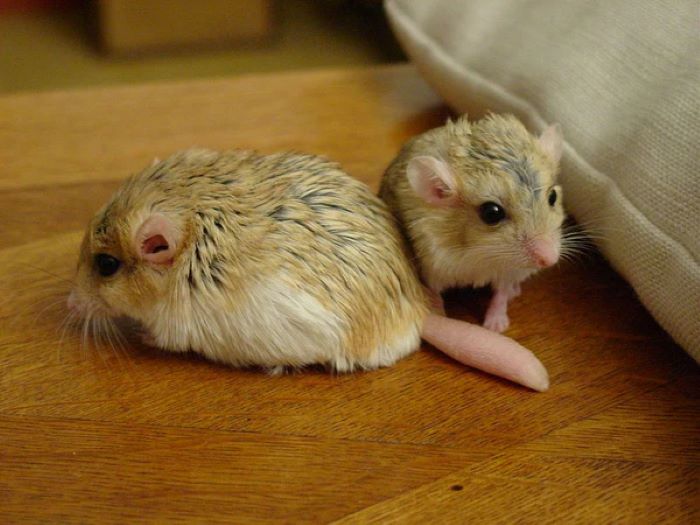Fat-tailed gerbils are the only other non-native gerbils kept as pets. They’re gaining popularity in North America and Europe. Northern African fat-tailed gerbils are desert gerbils. Algerian biologist Fernand Lataste found them in 1880.
The fat-tailed gerbil is a species of rodent that belongs to the subfamily Gerbillinae. It is also known as the Duprasi gerbil. Pachyuromys is a genus that contains only one species. These are the docile gerbils. Their fur is both silky and fluffy.
Sand and vegetation are the preferred habitats for this species of gerbils. They usually live in the rocky desert, another name for the Mediterranean desert. They are also occasionally found in coastal plains. They enjoy digging deep holes in the ground. Many individuals are getting fat-tailed gerbils as pets.
These gerbils can be differentiated from their Mongolian counterparts solely based on the thickness of their tails. They have a small, club-shaped, thick tail extending to about 2 inches, hence their moniker. This type of gerbil has distinctive seats because they use them to store fats and water. Therefore, the beautiful, rounded tail of a healthy fat-tailed gerbil is an excellent indicator of its health.
These gerbils have fluffy, lengthy fur. People often say that a fat-tailed gerbil is round, has oval, big eyes, and pink ears.

There will be variations in their color. The feet and bellies of many fat-tailed gerbils are white. On the other hand, most of these gerbils are tan or grey. They may also possess black pigmentation. As a result, different subspecies may have different colors.
Some hair grows on the palms and soles of the feet. The ears may also have some hair. Their tails are shorter in length compared to the rest of their bodies. If the seat is too thin, they are likely not receiving adequate nutrients or food.
The average adult fat-tailed gerbil is 108 mm long. Typically, they weigh about 36.5 grams.
Individually, Duprasi is an exceptional individual. In both appearance and behavior, they resemble cartoon characters. They move slowly but often fall asleep where they are standing. Although they are partially out of the wheel, it is not unusual to find a Duprasi slip out of their wheel sleep and remain asleep.
They are generally more nocturnal than Mongolians, so you may never see them when they are in their home and only awaken while asleep. In addition, they enjoy making a large nest out of nesting materials, so you may not see them even if you remove the cover from their home.
If you are desperate, they won’t bite if you disturb them sleeping or take them up, but they would bat you away with their front feet.
Occasionally, however, they don’t care and lay flat in your hand, even on their backs. They don’t appear to be in a rush at all.
A gerbil must have healthy teeth. A large portion of their upper incisors is covered with grooves. This permits them to chew their food better. In addition, their rooted molars allow for a more substantial bite. Having a gerbil with unhealthy teeth can cause various other health issues.
To dig effectively, Duprasi requires spacious terrariums with adequate bedding height. In addition, to avoid respiratory problems, make sure the bedding and the surroundings are well ventilated.
Fat tails help survive in the harsh desert habitat. This is because water and fat are stored in their seat. If the bottom of the Duprasi you just bought is too thin, it could mean that your pet isn’t getting enough food or nutrients.
A fat-tailed gerbil in good health would have a thick, delicate, fluffy coat.

Remember that gerbils can live longer if they’re healthy. Healthy fat-tailed gerbils can survive 5-7 years as pets. But most fat-tailed gerbils in the wild won’t live this long.
The majority of wild fat-tailed gerbils are very friendly. When kept as pets, they don’t try to get away and only bite when they are very scared. Consequently, when they are kept in an enclosure with another fat-tailed gerbil, they may become hostile and even try to eat it. They usually eat their young. If you have a pregnant female or one who has recently given birth, you need to keep a consistent look.
This gerbil species is nocturnal. In the wild, fat-tailed gerbils are most active at dusk and may be active at night and during the day. Fat-tailed gerbils aren’t particularly active as pets. Instead, they are busy, sleep for some time, and function.
However, despite their friendly nature to humans, fat-tailed gerbils prefer to live alone, but they don’t particularly enjoy the company of other gerbils.
All ages can enjoy Fat-Tailed Gerbils, but they are especially popular with children because of their loving nature. It’s similar to keeping your pet Pokemon, except without the battles. When you spend more time with your gerbils, they become more attached to you.
You can handle these calm furballs without fear of getting bitten.
Because they are nocturnal creatures in the wild, they make excellent pets for busy people. They may be active for a short time, sleep, and resume their activity.
A 24-inch aquarium is a fantastic home for these mammals because they are excellent burrowers, much more so than gerbils. Preferably use wood or paper shavings, not cedar, for the bottom of your container.
They prefer to climb, so secure the aquarium’s cover tightly. They also like to chew and can gnaw through plastic, so a wire mesh top should be used. In their habitat, they will burrow inside cardboard or PVC tubes.
Clumsy and prone to falling off, they use a hamster wheel. Please give them a dust bath with sand in a bowl occasionally so they can clean their fur.
The fat-tailed gerbil is an omnivore, consuming both plants and insects in its diet. Since it is a rodent that lives in dry and desert areas, it must be fed in a way that takes into account the traits it has developed in this type of environment. These young ones frequently have health issues due to consuming an improper diet that is excessively high in carbohydrates and fats.
If you get a fat-tailed gerbil as a pet, you must ensure that it receives the necessary nutrition. Mealworms, beetles, insects, vegetables, grain, and possibly little pieces of meat are some foods you will want to offer them. They primarily consume insects and vegetation.
Fat-tailed gerbils can be kept as pets by people. These gerbils are relatively docile. You can take care of them, and they’ll generally get along with you. Many owners of fat-tailed gerbils reported that their pets enjoyed being played with.
Like the other breeds of gerbils, fat-tailed gerbils are relatively new as pets, which makes it difficult to get one. They are more expensive because of this.
The price of a fat-tailed gerbil might vary depending on where it is obtained and what age it is. However, this variety of gerbil can usually be purchased for about $20 and $40.
The first phase in taking care of a pet is always to give it shelter or space that looks like it would have in the wild. Wood shavings are the finest bedding for rodents; pine and cedar can cause respiratory complications. Also, regular sand baths will keep their fur from being greasy.
Start giving your gerbil a wheel and tunnels to exercise and stimulate their creativity. Toys made of plastic should be avoided since they can be chewed and swallowed, which might clog their intestines. So instead of giving them toys, you may give them little pieces of wood or cardboard to chew.
The more you interact with your little gerbil, the better your relationship. For example, while holding them delicately in your palm, use the other hand to pet them gently. Make it a part of their daily routine so that they can be joyful and active every day.
Fresh fruit and vegetables will fill out your pet’s diet. For example, a nutritious diet for a Fat-tail gerbil would contain pellets, fruits, vegetables, nuts, and insects.
Even though they are social, fat-tailed gerbils are quite content to live alone, making them easy-to-care-for pets. They are not aggressive, rarely bite, and quickly adapt to being handled. As a result, they are the most docile members of the gerbil family.

Dr. Ananya Singh, the expert behind ThePetster.com, is a dedicated veterinarian with over 9 years of experience in animal health and welfare. She holds a Doctor of Veterinary Medicine (DVM) degree. Dr. Singh specializes in comprehensive pet care, preventative health, and holistic wellness. Follow her on Instagram for expert advice and updates.
